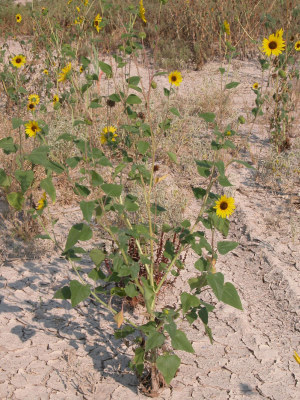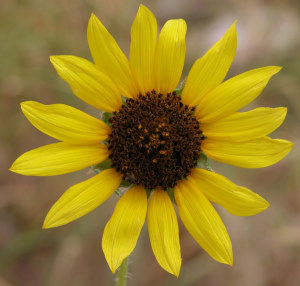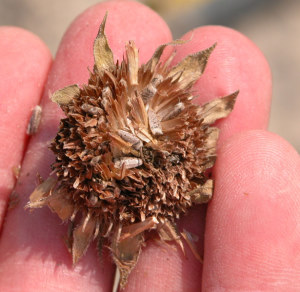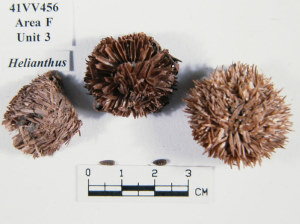Annual Sunflower
Helianthus annuus L
Asteraceae (Sunflower Family)
The annual sunflower is a very stout and upright plant that grows to heights of over 6 feet. Its seeds were a food source rich in fat (vegetable oil) and protein. Among some native groups, sunflower was used for medicinal and ritual purposes.
Sunflower leaves have a stalk and can measure over 12 inches long. The stem and leaves are covered with sticky hairs that attract many insects. Flowers can measure over 6 inches in diameter with yellow ray flowers (15-30) and purplish-brown disk flowers . The seeds are actually achenes, a hard seed-like fruit, which ripens in each of the dozens of disk flowers in the central "head" of the flower. Sunflowers grow in dense stands in disturbed areas throughout the Lower Pecos region, and attract butterflies, other insects, insect-eating birds, and seed-eating birds.
Archeological occurrence. Seed heads from wild-type sunflowers have been recovered from Fate Bell Shelter and from Hinds Cave. The heads were obviously removed from the plant and returned to the rockshelter only to be lost in the midden or trash deposits. Each head contained several seeds, as if they had been picked last week. However, the context from which the Hinds Cave specimen was recovered was dated to 1,200 years ago. Beyond the Lower Pecos rockshelters sunflower seeds have been recovered from archeological sites located along the Canadian River in the Panhandle of Texas, and in adjacent Oklahoma (Dering 2005; Drass 2005). All of the finds in Texas are from wild sunflowers, not domesticated sunflowers.
Domesticated sunflowers, detected in the archeological record by the comparatively large size of the achenes (seeds) were a component of the Eastern Agricultural Complex of oily-seeded and starchy seeded plants that preceded corn agriculture in North America. However, the story of sunflower domestication, especially when and where they were domesticated, is not yet fully understood. Sunflower was once thought to be native to the Colorado Plateau in the desert Southwest, and to have been traded into the eastern United States where it was domesticated (Heiser 1969). However, recent research has begun to change that picture. The earliest clearly domesticated sunflower seeds were recovered from the Hays site in eastern Tennessee and date to 4265 years ago (Ford 1997; Smith 1998:191). More recently, however, domesticated sunflower seeds from Tabasco, Mexico have been dated to 4,130 years ago, essentially contemporaneous with the finds in Tennessee, upsetting the impression that sunflowers were domesticated only in North America east of the Mississippi River (Lentz et al. 2001).
Recovery of wild-type seeds from archeological sites on the Texas-Mexican border has the potential to contribute to our understanding of sunflower domestication. The finds in the Lower Pecos area need to be direct-dated using the Atomic Mass Spectroscopy method of radiocarbon dating, particularly the sunflower head from Fate Bell shelter, which has extensive deposits exceeding 4,000 years in age. An early date from a wild-type sunflower would demonstrate that sunflowers were distributed more widely across the Southwest and closer to eastern Mexico during the middle Holocene than previously thought, and strengthen the idea that sunflowers may have been domesticated in Mesoamerica, or perhaps in two different areas.
Food and nutrition. Sunflowers produce seeds (achenes) very rich in oil (47%), protein (24%), and relatively low in carbohydrates (20%). They contain substantial amounts of both calcium and iron. The seeds ripen in late summer and fall.
Of all the Southwestern native groups, the Apache have the richest record of sunflower use. The Western Apache groups in particular recognized the importance of sunflowers in their diet. Wild sunflower patches were the property of specific groups, who staked out ownership by tying the sunflower heads together. When birds began to flock around the heads, it was harvest time. Some harvesters would use a large seed-beater and swat the seeds (achenes) out of the dried, brown flower into a basket, or simply cut the heads off and remove the seeds later. The Northern Tonto used an ash wood knife, and the Cibecue a knife fashioned from stone, to sever the heads, not surprising because a mature sunflower has a very tough stem (Buskirk 1986; Reagan 1928).
Parching, a technique in which hot coals are placed on a flat or slightly concave tray filled with seeds, was an important part of sunflower achene processing, perhaps because the achenes are so oily. The person would shake the tray filled with coals and seeds, repeatedly exposing the seeds to high temperatures. Once they had been parched, the seeds were much easier to grind into meal or flour using a mano and metate (Gifford 1936).
Many California groups utilized wild sunflower both on a seasonal basis or collected and stored the seeds for overwintering. The Yavapai and Northeastern Yavapai of California harvested wild stands of sunflowers in the fall. The Cahuilla considered sunflower to be an important addition to starchy seeds, drying and grinding the achenes and mixing them with other seeds (Bean and Saubel 1972:76). Although the California reports state that these were examples of Helianthus annuus, the actual plant utilized may refer to other closely related species.
The Havasupai toasted the achenes in live coals using an earth-covered tray, then ground them into meal. The meal was pressed into cakes and baked in hot coals (Weber and Seaman 1985). Parched and ground achenes were made into seed butter by adding a little water (Cushing 1965; Nabhan 1985). The importance of the sunflower is illustrated by reports that the Havasupai prepared and stored the achenes over the winter. The Yuman Indians parched, winnowed, and ground the achenes (Castetter and Bell 1951:187).
Medicine and ritual. The White Mountain Apache smashed the whole plant on a metate and applied it to snake bites (Reagan 1928:158). Sunflower roots are also applied to snake bites by the Zuni, who combined it with woolly paper flower (Psilostrophe tagetina) and blue star (Amsonia brevifolia) (Stevenson 1915:53). The Mescalero applied a ritual design on datil cakes (Yucca baccata fruit) using the yellow petals (Basehart 1960:51).
Sunflower takes on symbolic and ceremonial significance among the Zuni, who use it in rain-making ceremonies. In preparation for the ceremony, the Uwannami (rain makers) attach the sunflower symbol to their forelock. Specially selected men are assigned to collect the flowers directly into a sack, which is turned over to women who separate the ray flowers and grind them with Psilotrophe tagetina (woolly paper flower, another member of the sunflower family with yellow petals). This is done because "the Council of the Gods desire that these flowers shall be ground after the Sun Father has gone to his house and the winds have ceased to move" (Stevenson 1915:93).
References:
Bean, Lowell J. and Katherine S. Saubel
1972 Temalpakh: Cahuilla Indian Knowledge and Usage of Plants. Malki Museum Press. Morongo Indian Reservation, Banning, California.
Basehart, Harry
1960 Mescalero Apache Subsistence Patterns and Socio-Political Organization. The University of New Mexico Mescalero-Chiricahua Land Claims Project Contract Research #290-154. University of New Mexico. Albuquerque, New Mexico.
Buskirk, Winfred
1986 The Western Apache: Living with the Land Before 1950. University of Oklahoma Press, Norman, Oklahoma.
Castetter, Edward F. and Willis H. Bell
1951 Yuman Indian Agriculture. University of New Mexico Press, Albuquerque, New Mexico.
Cushing, Frank H.
1965 The Nation of the Willows. Northland Press, Flagstaff, Arizona.
Dering, J. Philip
2005 Plant Remains from Hank's site, Roberts County, Texas. Ms. On file at Prewitt and Associates, Inc. Austin, Texas.
Drass, Richard
2005 Corn, Beans and Bison: Cultivated Plants and Changing Economies of the Late Prehistoric Villagers on the Plains of Oklahoma and Northwest Texas. Paper presented at the Annual Meeting of the Society for Economic Botany, Fort Worth, Texas. June 9, 2005.
Ford, Richard I.
1997 Agricultural Origins in North America. The Review of Archaeology 19(1):12-18.
Gifford, Edward Winslow
1936 Northeastern and Western Yavapai. University of California Publications in American Archaeology and Ethnography 34:247-354.
Heiser, Charles B.
1969 The North American Sunflowers (Helianthus). Memoirs of the Torrey Botanical Club 22:1-217.
Lentz, D. L., Mary Pohl, Kevin Pope, and Andrew R. Wyatt
2001 Prehistoric Sunflower (Helianthus annuus L.) Domestication in Mexico. Economic Botany 55(3):231-239.
Nabhan, Gary
1985 Gathering the Desert. University of Arizona Press. Tucson, Arizona.
Reagan, Albert D.
1928 Plants Used by the White Mountain Apache Indians of Arizona. Wisconsin Archeologist 8:143-161.
Smith, Bruce D.
1998 The Emergence of Agriculture. Scientific American Press, New York.
Stevenson, Matilda Coxe
1915 Ethnobotany of the Zuni Indians. Thirtieth Annual Report of the Bureau of American Ethnology, [1908-1909], pp. 35-103. Washington, D.C.
Watt, B. K. and A. L. Merrill
1963 Composition of Foods. Agricultural Handbook No. 8. United States Department of Agriculture, Washington, D.C.
Weber, Steven A. and P. David Seaman
1985 Havasupai Habitat: A. F. Whiting's Ethnography of a Traditional Indian Culture. University of Arizona Press, Tucson, Arizona.
![]()



